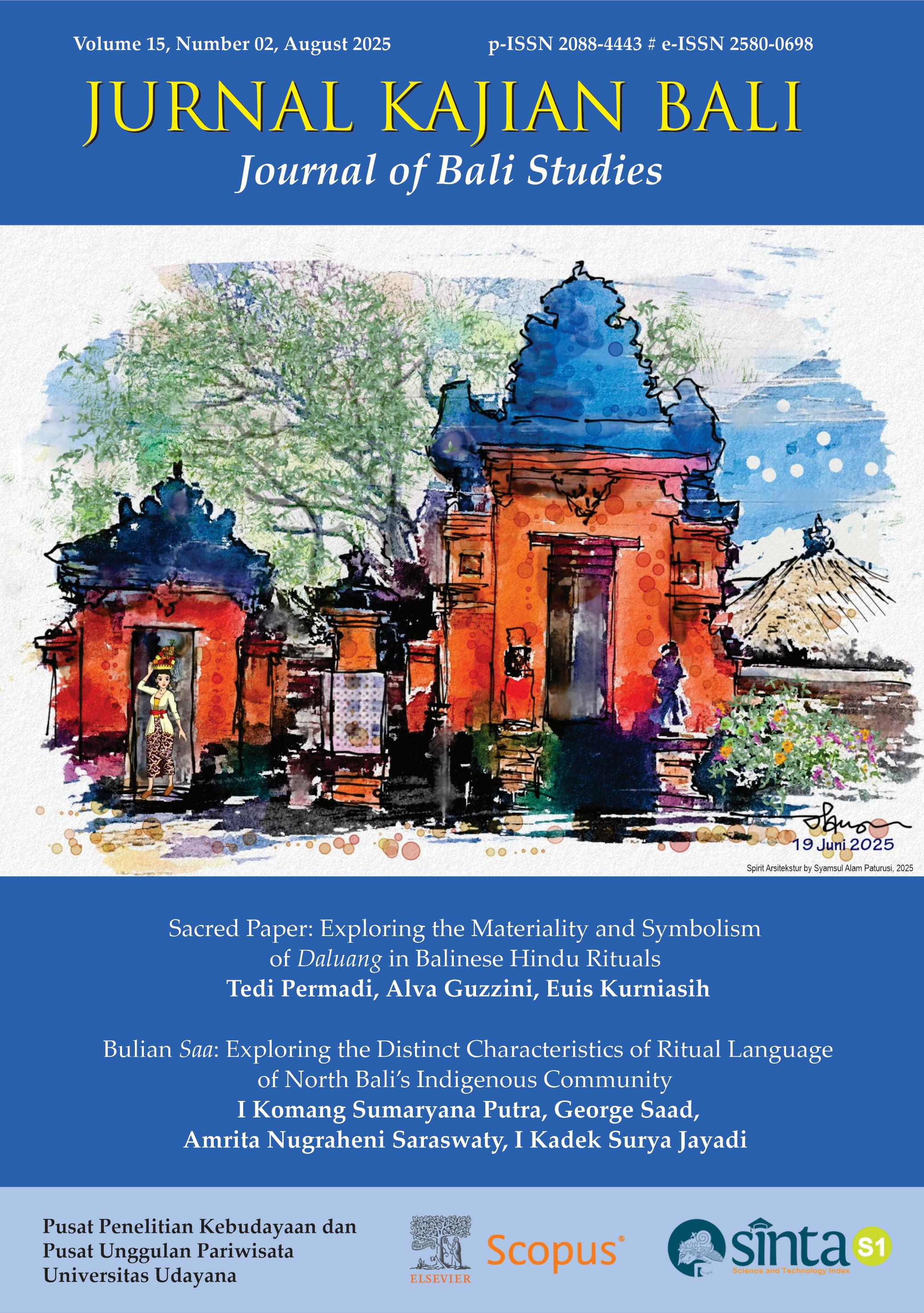Bali’s Legong Pancer Langit Dance as Cultural Diplomacy and National Identity Construction: A Case Study of the Jeddah Festival
DOI:
https://doi.org/10.24843/JKB.2025.v15.i02.p04Keywords:
cultural diplomacy, soft power, national identity, Balinese Pancer Langit danceAbstract
This study examines the role of the Legong Pancer Langit Dance, a Balinese Hindu tradition rooted in Tri Hita Karana (harmony with God, humans, and nature), as a vehicle for cultural diplomacy and national character strengthening. Focusing on its 2023 performance at the Jeddah Cultural Festival, the research uses qualitative methods including interviews, observations, and document analysis. The movements like mutering jagat (rotational steps symbolizing unity) and ngelayak (back-bridge posture reflecting environmental stewardship) resonated with Islamic values such as tawazun (balance) and habluminnallah (human-God harmony). Adaptations like modest costumes and viral campaigns (#LegongEyeChallenge), enabled the dance to navigate cultural sensitivities while preserving authenticity. The study highlights the dance facilitated intercultural dialogue, reinforcing Pancasila values, and projecting national identity. Policy recommendations incorporating traditional arts into diplomatic education and leveraging augmented reality (AR) for heritage preservation. Ultimately, the Legong Pancer Langit exemplifies how intangible heritage can strengthen cultural diplomacy in globalized contexts.
References
Aditya, M. C. P. (2024). Revitalisasi Tari Radat Selimut Putih: Menjembatani Pendidikan Karakter dan Pemahaman Budaya Lokal melalui Manajemen Seni Pertunjukan. Academy of Education Journal, 15(1), 348–356. https://doi.org/10.47200/aoej.v15i1.2193
Amalia, N. H. (2023). Cultural Diplomacy through Hallyu: Managing Bilateral Relations between South Korea and Indonesia. Jurnal Ilmiah Manajemen Kesatuan, 11(3), 889–896. https://doi.org/10.37641/jimkes.v11i3.2167
Ananda, M. N., & Anjani, N. D. (2024). Eksistensi seni tari kreasi modern dalam mengembangkan nilai karakter oleh kampus mengajar 7 di SDN 22 Ampenan. AL-MUJAHIDAH | Jurnal Pendidikan Guru Madrasah Ibtidaiyah, 5(2). https://doi.org/10.51806/al-mujahidah.v5i2.139
Anggraeni, D., Hakam, A., Mardhiah, I., & Lubis, Z. (2019). Membangun Peradaban Bangsa Melalui Religiusitas Berbasis Budaya Lokal (Analisis Tradisi Palang Pintu pada Budaya Betawi). Jurnal Online Studi Al-Qur’an, 15(1), 95–116. https://doi.org/10.21009/jsq.015.1.05
Ardjo, I. D. (2011). 200 Tahun Seni di Bandung. Pusbitari Press.
Aritonang, D. E., Silitonga, R. H., & Hutauruk, D. A. N. (2023). Relasi Alam dengan Eksistensi Manusia Terhadap Krisis Ekologi Berdasarkan Perspektif Filsafat-Teologis. DIEGESIS: Jurnal Teologi Kharismatika, 6(2), 138–155. https://doi.org/10.53547/diegesis.v6i2.489
Astita, I. N., Geria, I. W., Catra, N., Widyatmika, I. M. A., Candrayana, I. B., & Putra, Y. I. M. (2015). Peta Kesenian dan Budaya Bali: Seni Pertunjukan Modal Dasar Pesta Kesenian Bali dan Pembangunan Bali Berkelanjutan. DEVA Communications.
Baruah, A. D. (2024). Influence of Soft Power in shaping Diplomacy and Foreign Policy. Electronic Journal of Social and Strategic Studies, 05(02), 363–389. https://doi.org/10.47362/ejsss.2024.5214
Bhabha, H. K. (2012). The Location of Culture. Routledge. https://doi.org/10.4324/9780203820551
Braun, V., & Clarke, V. (2006). Using Thematic Analysis in Psychology. Taylor & Francis, 3(2), 77–101.
Cohen, M. I. (2019). Three Eras of Indonesian Arts Diplomacy. Bijdragen Tot de Taal-, Land- En Volkenkunde, 175(2–3), 253–283. https://doi.org/10.1163/22134379-17502022
Creswell, J. W., & Creswell, J. D. (2018). Research Design: Qualitative, Quantitative, and Mixed Methods Approaches (Fifth). SAGE Publications.
Cull, N. J. (2019). Public Diplomacy: Foundations for Global Engagement in the Digital Age. John Wiley & Sons.
Dana, I. W., Sya’bani, D. M., Riyanti, M. T., Abdullah, F., Azizan, A. T., Wardoyo, B. T., Astuti, F., Suaka, I. N., Zahar, I., Mustaqim, K., Jama, K. B., Diwyarthi, N. D. M. S., Hartiningsih, S., Rejo, U., Rohmah, N. B., & Vianey, W. Y. (2022). Multikultural dan Prospek Dialog Lintas Budaya di Era Kebebasan Berekspresi (Y. Kasmahidayat & Hasanuddin, Eds.; First). Pustaka Larasan.
Davies, S. (2011). The Role of Westerners in the Conservation of the Legong Dance. 3. https://digitalcommons.risd.edu/cgi/viewcontent.cgi?article=1114&context=liberalarts _contempaesthetics
Djuned, M. (2023). Relasi Manusia dan Lingkungan Hidup dalam Islam. SINTHOP: Media Kajian Pendidikan, Agama, Sosial Dan Budaya, 2(2), 124–134. https://doi.org/10.22373/sinthop.v2i2.4080
Enaim, R., & Amine El Alamy, Y. (2023). Cultural Diplomacy’s Effectiveness in Boosting Mutual Understanding. International Journal of Linguistics, Literature and Translation, 108–113. https://doi.org/10.32996/ijllt
Fathonah, M., & Puguh, D. R. (2022). Lawatan Misi Kesenian Mangkunegaran ke Mancanegara 1989: Kontribusi bagi Pembangunan Nasional. Jurnal Sejarah Citra Lekha, 7(1), 74–84. https://doi.org/10.14710/jscl.v7i1.46597
Gareis, E. (2023). Intercultural Friendships. Obo in Communication. https://doi.org/10.1093/obo/9780199756841-0292
Himayati, B. R. A., Elmiati, E., Mispalah, M., & Nursaly, B. R. (2024). Integrasi Praktik Menari Tradisional dalam Kurikulum (Membangun Kreativitas dan Kepribadian Siswa). JOEAI (Journal of Education and Instruction), 7(2). https://doi.org/10.31539/joeai.v7i2.10050
Hocking, B., & Melissen, J. (2015). Diplomacy in the Digital Age. Netherlands Institute of International Relations Clingendael.
Imran, A., Malik, M., & Ardjo, I. D. (2011). 5 Dasa Warsa Irawati Menari. Pusbitari Press.
Ishlah, T. P. (2019). Alasan Indonesia Menjalankan Diplomasi Kuliner di Inggris periode 2015-2017. Universitas Islam Negeri Syarif Hidayatullah.
Jazuli, M., & Paranti, L. (2022). Manajemen Sanggar Seni Tari di Semarang. Widyadharma : Inovasi Pembelajaran Pendidikan Seni Drama, Tari dan Musik, 101–107.
Jember Costume Industry. (2023). Legong Pancer Langit Dance social media engagement analytics. Unpublished Document.
Jember Costume Industry. (2023). Post-event engagement report: Jeddah Cultural Festival. Unpublished Document.
Kasmahidayat, Y. (2021). Analysis of Philosophical Value in Pencak Silat’S Salutation and Prasetya Three Move As a Sundanese’S View of Life. International Journal of Creative Industries, 3(8), 96–107. https://doi.org/10.35631/ijcrei.38008
Khairunnisa, B. W. (2024). Indonesia’s Engagement in Cultural Diplomacy Shaping its International Image. International Journal of Social Science and Human Research, 7(5), 3252–3259. https://doi.org/10.47191/ijsshr/v7-i05-86
Kim, Y. (2022). Soft Power and Cultural Nationalism: Globalization of the Korean Wave (1st Edition). Routledge.
Kovalchuk, O., & Bogdan, D. (2021). Scenography and Costume in Japanese Kabuki Theater: Traditions and Modernity. Research and Methodological Works of the National Academy of Visual Arts and Architecture, 30, 45–51. https://doi.org/10.33838/naoma.30.2021.45-51
Krippendorff, Klaus. (2018). Content analysis: an introduction to its methodology (4th Edition). Sage Publication.
Langi, K.-C., & Park, S. (2017). An Analysis of the Characteristics of Balinese Costume: - Focus on the Legong Dance Costume -. Journal of the Korean Society of Costume, 67(4), 38–57. https://doi.org/10.7233/jksc.2017.67.4.038
Leiter, S. L. (2015). A Kabuki Reader: History and Performance. Routledge.
Lestari, N. K. A. D., Suryani, N. N. M., & Sutirtha, I. W. (2023). Representasi Spirit Hyang Pertiwi dalam Tari Legong Kreasi Maha Widya. Jurnal Igel: Journal of Dance, 3(1), 17–26. https://doi.org/10.59997/journalofdance.v3i1.2374
Lindsay, J., & Liem, M. H. T. (2012). Heirs the World Culture Being Indonesian 1950-1965. KITLV Press.
Li, Y. (2023). Art diplomacy: Drawing China-Indonesia relations in the early Cold War, 1949–1956. Modern Asian Studies, 57(6), 1707–1742. https://doi.org/10.1017/S0026749X23000227
Mariyono, D., Alifatul Kamila, A. N., & Alif Hidayatullah, A. N. (2024). Unity in diversity: navigating global connections through cultural exchange. In Quality Education for All (Vol. 2, Issue 1, pp. 114–137). Emerald Publishing. https://doi.org/10.1108/QEA-10-2024-0122
Marjaya, I. M. (2008). Tri Hita Karana a Conception in Conducting Balinese Arts. Mudra Special Edition, 1–16.
Maryono, M., Widawati, S., Yuliarmaheni, N. N., MD, S., Wahyudiarto, D., & Midiyanto, M. (2022). Relevance of the Values of Bedhaya Ketawang in the Life of Society Today. Gelar: Jurnal Seni Budaya, 20(2), 109–120. https://doi.org/10.33153/glr.v20i2.4576
Merdekawati, B. T., & Supriyanto, S. (2022). Bentuk Tari Bedhaya Kawung karya M.G Sugiyarti. Greget, 21(1), 8–20. https://doi.org/10.33153/grt.v21i1.4436
Ministry of Culture, I. (2023). Sanskriti initiative: Bridging tradition and modernity (121). Government of India.
Nainggolan, E. A. (2022). Diplomasi Budaya Indonesia melalui Program Diplomasi Wayang dengan Amerika Serikat. Jurnal Transformasi Global. https://www.researchgate.net/publication/364278477
Nugroho, R. A., Argeni, G., & Gustianti, N. A. (2024). Rumah Budaya Indonesia di Belgia Sebagai Sarana Diplomasi Budaya Indonesia. INNOVATIVE: Journal of Social Science Research, 4(1), 4976–4985. https://doi.org/10.31004/innovative.v4i1.8335
Nuriarta, I. W., Suarka, I. N., Sari, I. A. L., & Suryadi. (2024). Articulation of Indonesian Identity in Mahabharata Epic Puppet Comics by Sundanese, Javanese, and Balinese Comic Artists. Jurnal Kajian Bali, 14(1), 19–44. https://doi.org/10.24843/JKB.2024.v14.i01.p02
Nye, J. S. (2004). Soft Power: The Means to Success in World Politics. PublicAffairs.
Oktavianus, O., Citrawati, A. A. I. A., Nurmalena, N., & Fakhrizal, H. (2024). Makna Simbolis dan Filosofi di Balik Gerakan Tari Tradisional Indonesia. AKSARA: Jurnal Bahasa Dan Sastra, 25(2), 760–772. https://doi.org/10.23960/aksara/v25i2.pp760-772P
Peters, J. H., & Wardana, W. (2013). Tri Hita Karana the Spirit of Bali (1st ed.). KPG (Kepustakaan Populer Gramedia).
Purwasito, A., & Kartinawati, E. (2019). Wayang dan Batik sebagai Wahana Praktek Diplomasi Kebudayaan. Kawruh: Journal of Language Education, Literature, and Local Culture, 1(2).
Rahapsari, S. (2021). The quest of finding the self in the Bedhaya: Unravelling the psychological significance of the Javanese sacred dance. Culture & Psychology, 28(3), 413–432. https://doi.org/10.1177/1354067X211047441
Rahmawati, A. N., Subiyantoro, S., & Widiyastuti, E. (2020). The Role of Art Education Through the Learning of Traditional Dance in Elementary School. Advances in Social Science, Education and Humanities Research, 421, 8–14.
Ramadani, N. (2023). Extracurricular Traditional Dance Art in Inculcating the Values of Tolerance and Love for the Homeland. Scaffolding: Jurnal Pendidikan Islam Dan Multikulturalisme, 5(1), 690–704. https://doi.org/10.37680/scaffolding.v5i1.2793
Ryniejska-Kiełdanowicz, M. (2021). Dyplomacja kulturalna jako narzędzie miękkiej siły Unii Europejskiej. Politeja, 12(37), 143–160. https://doi.org/10.12797/politeja.12.2015.37.10
Shay, A. (2002). Choreographic Politics: State Folk Dance Companies, Representation and Power. Wesleyan University Press.
Sh, H. (2024, January 22). Little Asia: A Trip Through Asian Culture and Delights. Destination KSA. https://destinationksa.com/en/little-asia-a-trip-through-asian-culture-and-delights/
Steelyana, E., & WawoRuntu, I. (2024). Batik and Tenun Endek Diplomacy as a Cultural Legacy from Soeharto’s to Jokowi’s Administration. Humaniora, 15(1), 43–53. https://doi.org/10.21512/humaniora.v15i1.11082
Sumaryanto, T. (2007). Pendekatan Kuantitatif dan Kualitatif dalam penelitian pendidikan seni. UNNES Press.
Sunaryo, A., Hapidzin, R. I., Jaohari, E. J., Endrayanto, Y., & Santana, F. D. T. (2024). Koreografi Interkultural: Mengokohkan Identitas Budaya melalui Kolaborasi Seni pada Bandung Isola Performing Art Festival (BIPAF). Jurnal Panggung, 34(3), 70–86. https://doi.org/10.26742/panggung.v34i1.2830
Ulrichsen, K. C. (2021). Cultural and Religious Diplomacy as Soft Power in EU-GCC Relations. In Contemporary Gulf Studies. Palgrave Macmillan.
UNESCO. (2005). Convention on the Protection and Promotion of the Diversity of Cultural Expressions.
UNESCO. (2022). Re|Shaping Policies for Creativity.
Utami, F. G. N. (2018). Tata Kelola Festival Seni Pertunjukan (First). ISI Press.
Viartasiwi, N., Trihartono, A., & Hara, A. E. (2021). Unpacking Indonesia’s Cultural Diplomacy: Potentials and Challenges. International Journal of Sustainable Future for Human Security, 7(2), 23–31. https://doi.org/10.24910/jsustain/7.2/2331
Vilar, E., Filgueiras, E., & Rebelo, F. (2022). Virtual and Augmented Reality for Architecture and Design (1st ed.). CRC Press. https://doi.org/10.1201/9781003051381
Wardhani, B. (2023). From Jakarta to Oceania: Indonesia’s Cultural Diplomacy with the South Pacific. Journal of Asian Security and International Affairs, 10(1), 1–18. https://doi.org/10.1177/23477970231152011
Whinarno, C., & Arifin, B. (2019). Pesan Dakwah dalam Pementasan Wayang Kulit Lakon “Ma’rifat Dewa Ruci” Oleh Dalang Ki Enthus Susmono. Jurnal Kopis, 2(1), 1–12. https://doi.org/10.33367/kpi.v2i1.1046
Wiratmaja, I. N., Suacana, I. W. G., & Sudana, I. W. (2021). Penggalian Nilai-Nilai Pancasila Berbasis Kearifan Lokal Bali Dalam Rangka Penguatan Wawasan Kebangsaan. Politicos: Jurnal Politik Dan Pemerintahan, 1(1), 43–52. https://doi.org/10.22225/politicos.1.1.3009.43-52
Yigit, S. (2024). Soft Power and Diplomatic Strategies in Asia and the Middle East. IGI Global Scientific Publishing. https://doi.org/10.4018/979-8-3693-2444-8.ch011
Yin, R. K. (2018). Case Study Research and Applications: Design and Methods. SAGE Publication.
Yudarta, I. G., Beratha, N. L. S., & Sudirga, I. K. (2025). Actualization of the Spirit of Nationhood in Karawitan Musical Compositions by Balinese Maestro I Wayan Beratha. Jurnal Kajian Bali, 15(1), 314–344. https://doi.org/10.24843/JKB.2025.v15.i01.p12
















